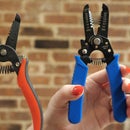Introduction: Quilted Vinyl Pencil Case
It all started with my new DIY motorcycle seat rebuild. I ordered some upholstery vinyl, fabric-backed foam, thick UV-resistant thread, and some bigger needles for my home sewing machine in the hopes of sewing my own seat cover. Although I have access to an industrial sewing machine, I like writing tutorials for you that are realistic to make at home. In this Instructable, I'll walk you through the process of creating this small pencil case, aka my practice project with these new-to-me materials. My primary resource in learning the techniques used here is a motorcycle seat cover tutorial by Sailrite, which is also the vendor of most of the materials used. If you are new to sewing, check out Mikaela's Machine Sewing Class and Jessy's Hand Sewing Class to get up to speed on the basics (especially the zipper installation).
For this project, you will need:
- Polyurethane Foam 1/2" With Fabric Backing, less than 1yd
- Nauga Soft Black Satin 54" Vinyl Fabric, less than 1yd
- UV-Resistant Thread V-69 Black Polyester
- Size 16 Machine Sewing Needle(s)
- 3M Super 77 Spray Adhesive
- Zipper
- Sewing Machine
- Scissors
- Ruler(s)
- Straight Pins
- Pencil/Pen, her are some of my faves:
To keep up with what I'm working on, follow me on YouTube, Instagram, Twitter, Pinterest, and subscribe to my newsletter. As an Amazon Associate I earn from qualifying purchases you make using my affiliate links.
Step 1: Draft Paper Pattern
I drafted up a pattern based on another pencil case I have, and sketched it up in my notebook and on some large paper. The pieces base measurements are as follows:
- Sides: 8 inches x 3 inches (20cm x 7.5cm)
- Edge: 21.5 inches x 2 inches (55cm x 5cm)
- Tab: .5 inch x 2 inches (1.5cm x 5cm)
To these measurements I added 5/8 inch seam allowance (1.5cm) as I drafted up the full size paper pattern.
Trace and cut the edge and tab pieces from your vinyl fabric. Cut a piece of vinyl big enough to fit two of your side panel pieces, with extra room all around to accommodate for the shrink that occurs from quilting. Cut a piece of fabric-backed foam that is slightly larger than this piece of vinyl.
Step 2: Foam Quilting
Protect your work surface and your eyes/lungs, then apply spray adhesive to the foam side of the fabric-backed foam and the back side of the upholstery vinyl. Allow the two pieces to sit for 30-60 seconds to become more tacky, then flip the fabric onto the foam and smooth it out. Trim the excess foam around the perimeter of the vinyl.
The fabric side of the foam should face the outside of the "sandwich" so that the stitching can catch it. Otherwise the stitching could tear through the foam.
Use a ruler to sketch out your desired quilting pattern on the vinyl. After some swatch tests, I determined that my sewing machine only performs well sewing this sandwich vinyl-side-up, so my marks needed to be on the right side of the project. If your machine makes nice-looking stitches sewing with the wrong side up, please feel free to make your markings on that side as well. I used a pencil so the marks wouldn't be too visible and could be removed with an eraser of needed.
Carefully stitch all the lines in your quilting pattern. I decided to start with the biggest lines and work my way towards the edges. Check on your bobbin frequently so you don't run out of thread in the middle of a line, as the hiccup will be visible in the final piece.
Trim off any excess threads around the edge, and congrats, you've got a quilted panel from which to cut your side pattern pieces!
Step 3: Cut Quilted Pieces
Trace the side panel pattern piece twice onto the quilted panel, minding the spacing and orientation of the quilted pattern.
Step 4: Zipper & Tab
Cut a slot in the edge piece and install the zipper (refer to Mikaela's excellent lesson on the topic rather than imitating my rather haphazard and less-than-perfect attempt). Fold and sew the tab piece in thirds lengthwise, then fold the whole thing in half and stitch across the short ends together.
Step 5: Put It All Together
It was a bit tricky to sew clean lines on such bulky and small pieces! Pins along the very edge (not anywhere where the hole would be visible on the outside of the final case) helped hold things in place while sewing.
Trim the excess foam and vinyl around the seams and clip perpendicular slits into the tight edge to release tension.
As you stitch the small seam linking the short ends of the edge piece, catch the tab piece in the stitching.
Step 6: Finishing Touches
Turn the case right-side-out and topstitch the edge/tab seam. Clip all stray threads and you're finished!
Step 7: Pack It Up!
Stuff your case with writing supplies or whatever else you like! Some of my favorites lately:
Thanks for reading my Instructable! I'd love to hear your comments and see your versions below.
If you like this project, you may be interested in some of my others:
- How to Install LEDs Under a Scooter (with Bluetooth)
- 3 Beginner Arduino Mistakes
- Throttle Cable Replacement on a 1975 Honda CB200T
- 13 Ideas for Diffusing LEDs
To keep up with what I'm working on, follow me on YouTube, Instagram, Twitter, Pinterest, and subscribe to my newsletter.





